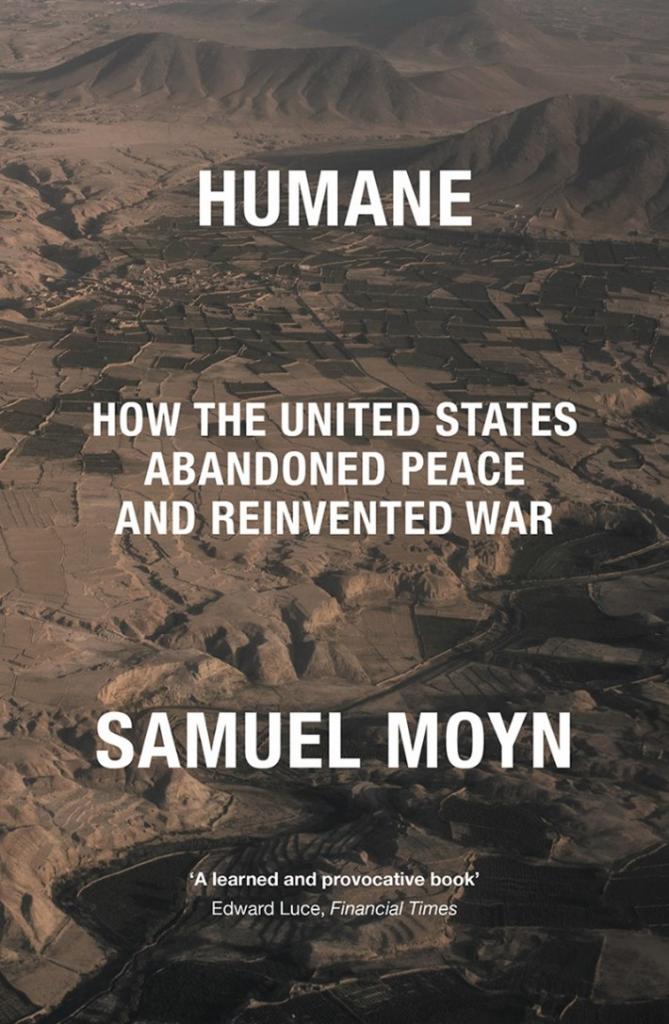Book Review - Humane: How the United States Abandoned Peace and Reinvented War by Samuel Moyn

Humane: How the United States Abandoned Peace and Reinvented War by Samuel Moyn. London: Verso 2022. 416 pp., £20 paperback 9781839766190, £20 e-book 9781839766213
Working to restrict the horrors of war contributes to making conflict longer and more frequent. The emphasis on the better treatment of prisoners, the ending of torture, and the reduction of civilian deaths has shifted attention from the why to the how wars are fought. This is the counter-intuitive and somehow paradoxical argument at the core of Samuel Moyn’s latest book, Humane: How the United States Abandoned Peace and Reinvented War. Moyn, a professor of law and history at Yale University, makes a claim that sounds revolutionary but is actually not completely new. As the author himself explains early in the book, the great Russian novelist and pacifist Leo Tolstoy already “understood that humanity in warfare, for all its virtues, opened up the possibility of a new vice— facilitating and legitimating war rather than controlling its outbreak or ending its continuation” (p. 45). Humane can certainly be considered a ground-breaking work. It does not present an entirely novel point of view, but carefully examines how Tolstoy’s prophecy came to be a dangerous reality. And in doing so, it provides valuable lessons.
Moyn’s book is to an important extent a historical account of the evolution of war and international law from the late nineteenth century up to the present day. Its structure is broadly divided chronologically into two halves. The first half, covering the period up to the end of the Second World War, presents a global perspective. The second half, on the contrary, mainly discusses developments in US warfare and society.
 The Yale professor has a special ability to bring the characters populating Humane into life. Some lend themselves particularly well to Moyn’s talent. That is the case of Bertha von Suttner, whose life “reads like a novel by Leo Tolstoy.” Von Suttner, who exchanged correspondence with the writer of ‘War and Peace’, married secretly and fled to the Caucasus with her new husband. She would have an “electrifying effect (…) upon the world” with her pacifist novel “Lay Down Your Arms!” and become the first woman to win the Nobel Peace Prize.
The Yale professor has a special ability to bring the characters populating Humane into life. Some lend themselves particularly well to Moyn’s talent. That is the case of Bertha von Suttner, whose life “reads like a novel by Leo Tolstoy.” Von Suttner, who exchanged correspondence with the writer of ‘War and Peace’, married secretly and fled to the Caucasus with her new husband. She would have an “electrifying effect (…) upon the world” with her pacifist novel “Lay Down Your Arms!” and become the first woman to win the Nobel Peace Prize.
Moyn refers to a discussion between Bertha von Suttner and Henri Dunant, who founded the Red Cross and won the Nobel Peace Prize in 1901. This exchange is highly illustrative of the risks accompanying the humanization of warfare and demonstrates Suttner’s awareness of their future significance. When Suttner knew that Dunant would give a speech as the recipient of the Prize, she entreated him:
“Give me a few lines, please, in which you prove that you are a bearer of the white flag”— not merely someone who “humanizes war” but “one of those who (after war has been humanized) wants to abolish war” (p. 80).
Neither Suttner’s nor the following generation had much reason to worry about the humanization of warfare. Even after the Second World War, mobilization in the name of humane warfare was nowhere to be seen. Strong proof of that, argues Moyn, is that the Nuremberg Trials concluded that the crime of aggression had been the premier evil of Nazi Germany. The newly coined term of ‘crimes against humanity’ resonated widely in the halls of Courtroom 600 of the Nuremberg Palace of Justice. Nevertheless, “the charge was only allowed in connection with the primary infraction of aggressive war” (p. 143).
The emergence of a growing movement to humanize war had to wait until the early 1970s. The atrocities of Vietnam —prominent among them the My Lai massacre— played a decisive role in this development. Moyn sees these years as a bright moment in history, since at that time “concerns about how the United States fought were explicitly linked to what justification the country had to fight at all” (p. 163). The situation was to change soon, however, and partly because of the military’s own readiness to work towards the humanization of warfare. A new implicit bargain emerged by which new generations of activists and the military:
“would agree to contend with each other not over whether the United States went to war— a question the new humanitarians were actually less concerned about than militaries interested in avoiding losses— as over how” (p. 207).
The new focus on the humanization of warfare to the detriment of a general discussion on the appropriateness of conflict in the first place was epitomized by the period following the US invasion of Iraq in 2003. Americans, argues Moyn, were appalled by the mistreatment and torture of prisoners at the hands of US soldiers shown in the Abu Ghraib pictures. Although taking place in simultaneous fashion, the expansion and extension of the Iraq war sadly received far less attention.
Moyn’s main argument in Humane, that working to mitigate the horrors of war may lead to longer and more frequent conflicts, is undoubtedly controversial. Furthermore, on some occasions the causal links between the two elements of Moyn’s thesis are not as clearly detailed as they should be in order to convince the most skeptical readers. This notwithstanding, some of the criticism aimed at the author after he presented the main points of Humane in article format was clearly unreasonable. Cornell University Professor Joseph Margulies and Baher Azmy, Legal Director of the Center of Constitutional Rights, have suggested that had Moyn hypothetically been in a position to decide whether to litigate against the US government for the illegal detention of prisoners at Guantánamo — as Margulies and his colleagues did in 2002 —he might well have said: “The detention is inhumane, but so is the whole enterprise. Your litigation will only humanize the war, and that would be a terrible tragedy.” Those who read Moyn’s book will discover that such an accusation is nothing but unfair.
Moyn is by no means straightforward in Humane when it comes to proposing a way out of the challenges presented by humane warfare. The scarcity of proposals might be related to his particular attention to the United States and its military activities in the second half of the book. The massive demonstrations against the Iraq war in Europe in 2003, for instance, are only mentioned in passing. This popular mobilization demonstrated that, at least in Europe, millions of people were still concerned about why wars are fought.
In a 2018 opinion piece that reflects the points raised in Moyn’s concluding remarks in Humane, the author noted positively that the two last US presidents had been elected “as antiwar candidates, even though each went on to govern militaristically.” Two years later, he held little hopes that the Biden presidency would represent a change and has recently argued that his concerns were vindicated.
The fact that three consecutive US presidents have campaigned on the need to end wars but have continued them speaks for the power of the military-industrial complex and the humane warfare paradigm. Conversely, the period of dual fight in the early 1970s United States against both inhumane warfare and the very same conduct of war — the moment Moyn cherishes so much— speaks for the possibility of a brighter future.
Marc Martorell Junyent is a freelance book reviewer who is currently completing a Master’s in Comparative and Middle East Politics and Society at the University of Tübingen, Germany. He graduated in International Relations at Ramon Lull University, Barcelona. He tweets at @MarcMartorell3


